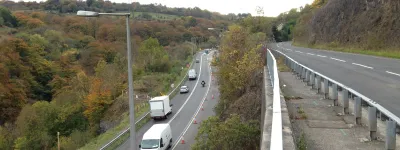
With its busy market, narrow shopping streets and throngs of pedestrians, Camden Town is not designed for road traffic. With Ringway 1 came a plan to provide this inner London town centre with a bypass.
It was recognised in the 1960s that the several routes converging on the town centre were a source of much congestion locally and that a solution should be found. The traffic there is bad today, but it would have become much worse if the North Cross Route had been built. The motorway was closest to the A501 Euston Road — and therefore to central London — where it passed Camden, and it would be tempting for traffic to hop between the two at that point. Without a better road to get to and from the motorway, Camden's future looked grim.
The GLC's solution came bundled up with the plans for Ringway 1's North Cross Route, presumably because the logical route for the bypass followed part of the motorway's alignment. Travers-Morgan, consulting engineers for the report on the North Cross Route, produced a second report a month or two later with full plans for the Camden Town Bypass, indicating that the two were planned as one large scheme.
Outline itinerary
Flows into A503 Camden Road
A5202 Royal College Street
Ringway 1 North Cross Route
A502 Chalk Farm Road
A400 Mornington Crescent
Flows into A400 Hampstead Road
Route map

Route description
This description begins at the north end of the route and travels south.
Travelling southbound, the Bypass would have started on a widened A503 Camden Road, where a dual-carriageway would rise from the middle of the road. Below it, sliproads would allow traffic on Royal College Street to reach the A503 to and from the north. The road would then turn west, taking out the south side of Bonny Street, to run elevated above ground level to clear Camden Street. Here the North Cross Route would run on the upper deck above it. Sliproads would have run up and down to connect the two, allowing east-to-east and west-to-west movements between the two roads.
The short double deck section would end as the Bypass was to turn south-west across Camden High Street. South-facing sliproads would allow traffic to and from central London to access the North Cross Route to the west and the A502 Chalk Farm Road. This part of the route, with its sliproads overhead, would have run above the Regent's Canal at Camden Lock, obliterating what has since become one of London's most popular waterside gathering places.
Now a dual three-lane road, the bypass would turn south to run along the east side of the mainline railway to Euston. In order to preserve the grand crescent of terraced houses on Oval Road and Gloucester Crescent, the Bypass was to run below ground level, with Oval Road overhanging the southbound lanes, and a short cut-and-cover tunnel under Delancey Street.
Rising back to ground level, the Bypass would require the demolition of the southernmost block of buildings on Mornington Crescent, turning to cross the railway at a widened bridge. A new flyover would be built northbound to carry traffic from central London into Camden Town. The A400 Hampstead Road would then be widened to allow six traffic lanes to reach the Euston Underpass just to the south.
Under the radar
This scheme couldn't fail to be controversial. Despite following a railway for much of its length, it called for two of Camden's most pleasant and regal crescents to be defaced. By rights it should have caused a storm, but there are surprisingly few references to it. Most likely it always lived in the shadow of its larger relative, the North Cross Route.
The Bypass also seems to have been relatively short-lived: it was published, along with the whole of the North Cross Route, in an engineering report by consulting engineers Travers-Morgan in August 1966. The 1965 draft version of the same report, however, makes no mention of it, and shows a completely different arrangement, with the North Cross Route interchanging directly with the A503 Camden Road, and the latter realigned east of the town centre.
That would seem to indicate that the Bypass was a relatively late addition to the proposals, being drawn up in the space of a year between 1965 and 1966. It vanished, along with the rest of Ringway 1, in 1973, which means at most it was a proposal for some eight years. Perhaps that's why it never had the chance to cause as much controversy as one might expect. Nonetheless, one element of it was built and survives to this day: on Hampstead Road, about half of the distance from the Euston Underpass to Mornington Crescent was widened in the 1960s in exactly the manner described in the Camden Town Bypass plans, and today exists as a three-lane dual carriageway.
Sources
- Travers Morgan report, published route ca. 1966: MT 106/437
- Draft of Travers Morgan report without Camden Town Bypass: LCC/PP/HT/001
Picture credits
- Route map contains OS data © Crown copyright and database rights (2017) used under the terms of the Open Government Licence.
- Artist's impressions of Camden Town Bypass is from "New Roads in West and North Central London", GLC, 1965.

